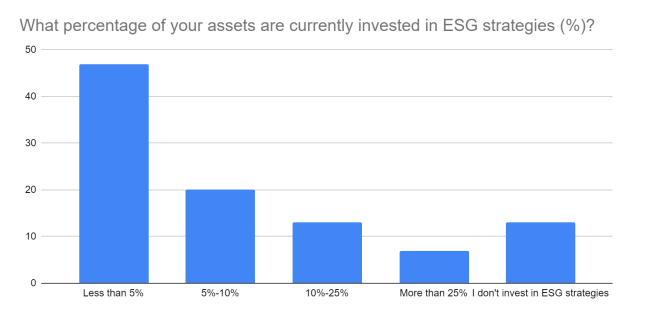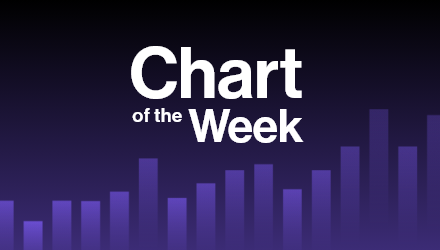While investing based on environmental, social, and governance (ESG) metrics may be a wave of the ETF future, it is not much more than a drip in the present. A few weeks back, I wrote an article that declared that ESG was not the anti-energy villain that some in the financial industry and in politics were making it into; the ETF asset base remained small at less than 2% of assets, and the lineup of products available was so diverse that it was wrong to call them anti-energy. Since then, VettaFi took things further. During a September webcast with State Street Global Advisors that focused solely on the merits and use cases of ESG investing, we surveyed advisors about how they were presently using such strategies.

Nearly half of the respondents (47%) said that ESG comprised less than 5% of their assets, while an additional one in five (20%) had between 5% and 10% invested in ESG. Meanwhile, nearly one in seven (13%) did not invest at all in ESG strategies, despite attending the webcast on the topic. Even as many advisors are eager to learn more about ESG, they have not come close to embracing these approaches.
For some interested advisors, ESG investing involves an exclusionary strategy, where certain companies are removed from a broader index-based approach. The SPDR S&P 500 Fossil Fuel Reserves Free ETF (SPYX) is a good example. The $1.1 billion ETF owns 489 of the stocks in the S&P 500 but has a 1% of assets stake in energy companies, which is less than the 4% position the sector represents in the SPDR S&P 500 ETF (SPY).
For others, ESG investing occurs through a thematic approach, with a more narrowly constructed index focused on companies positioned to benefit from demand for alternative energy. The Invesco Solar ETF (TAN) is one such fund. The $2.7 billion fund invests primarily in industrial, technology, and utility companies based around the world that are tied to solar energy. While companies like Enphase Energy and First Solar can be found in broader index-based products, they represent small stakes. An investment in TAN or its thematic ESG peers can augment a broader portfolio.
For the current minority of advisors using ESG as a meaningful portion of client portfolios, or seeking to do so, a best-in-class inclusionary approach is logical. The iShares ESG Aware MSCI USA ETF (ESGU) is the largest of such funds, with $21 billion in assets. ESGU owns companies in each of the 55 sectors that score well based on a wide range of environmental, social, and governance metrics, not just climate change.
The fund’s portfolio intentionally looks, at a quick glance, similar to the S&P 500 Index or other broad benchmarks, with 4.6% in energy companies and 28% in information technology companies. Exxon Mobil and Microsoft are among the 312 constituents. ESGU and peer ETFs can complement an advisor’s core equity exposure.
In the same survey of advisors, VettaFi asked, “How are you or will you implement ESG investing into client portfolios?” The most frequently cited answer given was “to experiment by adding some allocation, but not fully replace” (40%) followed by “use in a risk management strategy” (27%).
Advisors are exploring the ESG ETFs available to them and seeking out additional information through VettaFi. However, those who fear that ESG investing is taking over need to wake up from the dream and embrace the reality.
For more news, information, and strategy, visit the ESG Channel.

